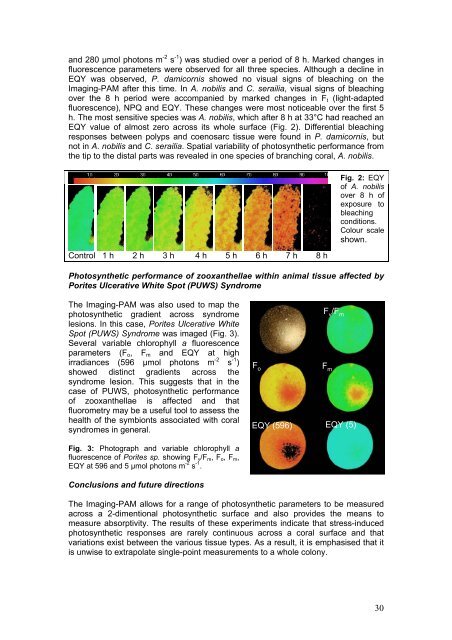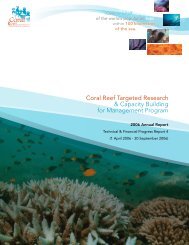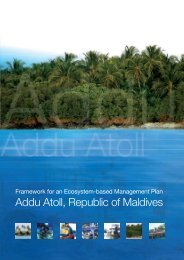Pulse Amplitude Modulation Fluorometry - Coral Reef Targeted ...
Pulse Amplitude Modulation Fluorometry - Coral Reef Targeted ...
Pulse Amplitude Modulation Fluorometry - Coral Reef Targeted ...
You also want an ePaper? Increase the reach of your titles
YUMPU automatically turns print PDFs into web optimized ePapers that Google loves.
and 280 µmol photons m -2 s -1 ) was studied over a period of 8 h. Marked changes influorescence parameters were observed for all three species. Although a decline inEQY was observed, P. damicornis showed no visual signs of bleaching on theImaging-PAM after this time. In A. nobilis and C. serailia, visual signs of bleachingover the 8 h period were accompanied by marked changes in F t (light-adaptedfluorescence), NPQ and EQY. These changes were most noticeable over the first 5h. The most sensitive species was A. nobilis, which after 8 h at 33°C had reached anEQY value of almost zero across its whole surface (Fig. 2). Differential bleachingresponses between polyps and coenosarc tissue were found in P. damicornis, butnot in A. nobilis and C. serailia. Spatial variability of photosynthetic performance fromthe tip to the distal parts was revealed in one species of branching coral, A. nobilis.Control 1 h 2 h 3 h 4 h 5 h 6 h 7 h 8 hFig. 2: EQYof A. nobilisover 8 h ofexposure tobleachingconditions.Colour scaleshown.Photosynthetic performance of zooxanthellae within animal tissue affected byPorites Ulcerative White Spot (PUWS) SyndromeThe Imaging-PAM was also used to map thephotosynthetic gradient across syndromelesions. In this case, Porites Ulcerative WhiteSpot (PUWS) Syndrome was imaged (Fig. 3).Several variable chlorophyll a fluorescenceparameters (F o , F m and EQY at highirradiances (596 µmol photons m -2 s -1 )showed distinct gradients across thesyndrome lesion. This suggests that in thecase of PUWS, photosynthetic performanceof zooxanthellae is affected and thatfluorometry may be a useful tool to assess thehealth of the symbionts associated with coralsyndromes in general.F v/F mF o F m EQY (596)EQY (5)F v/F m30Fig. 3: Photograph and variable chlorophyll afluorescence of Porites sp. showing F v /F m , F o , F m ,EQY at 596 and 5 µmol photons m -2 s -1 .Conclusions and future directionsThe Imaging-PAM allows for a range of photosynthetic parameters to be measuredacross a 2-dimentional photosynthetic surface and also provides the means tomeasure absorptivity. The results of these experiments indicate that stress-inducedphotosynthetic responses are rarely continuous across a coral surface and thatvariations exist between the various tissue types. As a result, it is emphasised that itis unwise to extrapolate single-point measurements to a whole colony.








